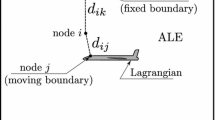Abstract
In this paper we present an application of the variational approach, introduced by Quartapelle and Napolitano (AIAA J 21:911–913, 1983) and developed further by Protas et al. (J Comput Phys 159:231–245, 2000), which requires only the velocity fields and its derivatives to determine forces acting on a body. First, the approach is presented and adapted to our 3D test problem. The obtained expression for the hydrodynamic force involves a harmonic function \(\eta\) whose determination is also presented. Then, numerical flow fields obtained with LES are used in order to evaluate the influence of different parameters on the forces and to offer a validation of the proposed approach. This allows us to assess the accuracy of the method and its advantages. Next, a comparison of the proposed variational approach with the momentum equation approach presented by David et al. (2009) is discussed. The momentum equation approach offers a non-intrusive method to determine forces, but requires the pressure field around the object. On the other hand, the variational approach requires the determination of the vorticity field on the surface of the wing, which is not always trivial to obtain with sufficient accuracy, but the computation of the pressure field can be avoided. This paper aims to compare both methods in a practical setting and show their relative advantages and sensitivities to different parameters for a 3D numerical/experimental study of a flow field around a NACA0015 airfoil. To the best of our knowledge, this is the first application of the variational approach in an experimental setting.












Similar content being viewed by others
References
Acher G (2019) Couplage de mesures de vitesse par Tomo-PIV et de déformation de profil, pour l’étude des interactions fluide-structure. Ph.D. Thesis, Universite de Poitiers
Acher G, Thomas L, Tremblais B, Gomit G, Chatellier L, David L (2019) Simultaneous measurements of flow velocity using Tomo-PIV and deformation of a flexible wing. In: Proceedings of the 13th International Symposium on Particle Image Velocimetry, Munich
Chang C-C (1992) Potential flow and forces for incompressible viscous flow. Proc R Soc A 437:517–525
Chang C-C, Lei S-Y (1996) On the sources of aerodynamic forces: steady flow around a cylinder or a sphere. Proc R Soc A 452:2369–2395
Chang C-C, Su J-Y, Lei S-Y (1998) On aerodynamic forces for viscous compressible flow. Theor Comput Fluid Dyn 10:71–90
David L, Jardin T, Farcy A (2009) On the non-intrusive evaluation of fluid forces with the momentum equation approach. Meas Sci Technol 20(9):095401
Gomit G, Acher G, Chatellier L, David L (2018) Uncertainty analysis of an optical method for pressure estimation in fluids. Meas Sci Technol 29(2):024004
Götten F, Finger F, Havermann M, Braun C, Marino M, Bil C (2019) A highly automated method for simulating airfoil characteristics at low Reynolds number using a RANS — transition approach. Deutscher Luft- und Raumfahrtkongress 2019 DocumentID: 490026
Howe MS (1995) On the force and moment on a body in an incompressible fluid, with application to rigid bodies and bubbles at high and low Reynolds numbers. Q J Mech Appl Math 48:401–426
Jardin T, Chatellier L, Farcy A, David L (2009) Correlation between vortex structures and unsteady loads for flapping motion in hover. Exp Fluids 47:655–664
Jeon YJ, Gomit G, Earl T, Chatellier L, David L (2018) Sequential least-square reconstruction of instantaneous pressure field around a body from TR-PIV. Exp Fluids 59(2):27
Kurtulus DF, Scarano F, David L (2007) Unsteady aerodynamic forces estimation on a square cylinder by TR-PIV. Exp Fluids 42(2):185–196
Lighthill J (1986) Fundamentals concerning wave loading offshore structures. J Fluid Mech 173:667–681
Limacher E, McClure J, Yarusevych S, Morton C (2020) Comparison of momentum and impulse formulations for PIV-based force estimation. Meas Sci Technol 31(5):054001
Lin JC, Rockwell D (1996) Force identification by vorticity fields: techniques based on flow imaging. J Fluids Struct 10:663–668
Noca F, Shiels D, Jeon D (1997) Measuring instantaneous fluid dynamic forces on bodies, using only velocity fields and their derivatives. J Fluids Struct 11:345–350
Noca F, Shiels D, Jeon D (1999) A comparison of methods for evaluating time-dependent fluid dynamic forces on bodies, using only velocity fields and their derivatives. J Fluids Struct 13:551–578
Pan LS, Chew YT (2002) A general formula for calculating forces on a 2-D arbitrary body in incompressible flow. J Fluids Struct 16:71–82
Protas B, Styczek A, Nowakowski A (2000) An Effective Approach to Computation of Force in Viscous Incompressible Flows. J Comput Phys 159:231–245
Protas B (2007) On an Attempt to Simplify the Quartapelle-Napolitano Approach to Computation of Hydrodynamic Forces in Open Flows. J Fluids Struct 23(8):1207–1214
Quartapelle L, Napolitano M (1983) Force and moment in incompressible flows. AIAA J 21:911–913
Shur ML, Spalart PR, Strelets MK, Travin AK (2008) A hybrid RANS-LES approach with delayed-DES and wall-modelled LES capabilities. Int J Heat Fluid Flow 29(6):1638–1649
Unal MF, Lin JC, Rockwell D (1997) Force prediction by PIV imaging: a momentum based approach. J Fluids Struct 11:965–971
Van Oudheusden BW, Scarano F, Casimiri EW (2006) Non-intrusive load characterization of an airfoil using PIV. Exp Fluids 40:988–992
Acknowledgements
The authors are grateful to an anonymous referee for constructive feedback which helped improve the presentation of the results. The current work has been conducted as part of the EVAPOR Astrid project, funded by the Agence Nationale de la Recherche and the DGA, Grant No. NR-16-ASTR-0005-01 and the CPER FEDER project of the Nouvelle Aquitaine Region. BP acknowledges partial support through an NSERC Discovery Grant.
Author information
Authors and Affiliations
Additional information
Publisher's Note
Springer Nature remains neutral with regard to jurisdictional claims in published maps and institutional affiliations.
Rights and permissions
About this article
Cite this article
Díaz-Arriba, D., Protas, B., Acher, G. et al. Application of a variational approach to the computation of forces around a wing. Exp Fluids 63, 31 (2022). https://doi.org/10.1007/s00348-021-03376-4
Received:
Revised:
Accepted:
Published:
DOI: https://doi.org/10.1007/s00348-021-03376-4




